Content
- 1 Popular types and varieties of lilies
- 2 How to choose lily bulbs
- 3 How to keep lilies before planting
- 4 Growing lily seedlings (preliminary early planting of bulbs in a pot)
- 5 Technology for planting lily bulbs in open ground
- 6 Outdoor care for lilies
- 7 Popular types and varieties of lilies
- 8 How to choose lily bulbs
- 9 How to keep lilies before planting
- 10 Growing lily seedlings (preliminary early planting of bulbs in a pot)
- 11 Technology for planting lily bulbs in open ground
- 12 Outdoor care for lilies
- 13 Spring planting of lilies
- 14 Mistakes when growing lilies
Lilies are one of the most popular flowers in summer cottages, which attract attention with their delicate, colorful and abundant flowering. Moreover, they give their own touch to the range of smells in the garden. As a rule, these flowers are planted in the fall, but recently spring planting of lilies in open ground has become popular. But in order to grow beautiful flowers, you first need to choose and buy high-quality planting material, save it until it is planted in a permanent place in the garden, plant it, and then properly care for the flower until autumn.

Popular types and varieties of lilies
As a rule, lilies, depending on their origin, are divided into the following groups of hybrids:
- Asian;
- Martagon;
- Candidum;
- American;
- Long-flowered;
- Tubular and Orleans;
- Oriental (orientalia).
There are also interspecific hybrids of lilies:
- LA hybrids (Asian + longiflorum);
- OT-hybrids (Orienpits - eastern + tubular);
- LO hybrids (long-flowered + oriental);
- OA hybrids (oriental + asian).
Video: species, varieties and hybrids of lilies
How to choose lily bulbs
The choice of planting material should be approached with the utmost seriousness if you want to get a flower that will delight you with abundant flowering and decorate your flower bed until autumn.
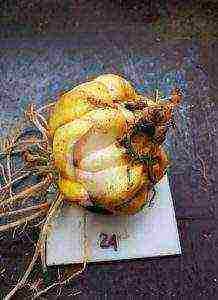
Here are some important points to pay attention to when choosing lily bulbs:
- The optimal size of the diameter of the bulb is 2-3 cm. If the bulbs are smaller, then most likely they are after forcing, which means that you will not get flowering immediately, but only in the 3rd year.
- The bulb should be firm to the touch and the scales should not fall apart. Excessive dryness and looseness are signs of poor-quality planting material.
- The specimen should not show any obscure spots or signs of rot.
- Donets should be in good condition, without damage, and the roots should be alive, not dry or completely rotten.
- The sprout should preferably sleep. If it has already begun to stretch, then such a bulb will have to be grown at home in a pot (in case of an early purchase) or immediately planted in open ground (if you bought it in May).
- The color of the bulb does not matter. The color is influenced by the type and variety.
How to keep lilies before planting
If you bought lily bulbs in advance, or they were presented to you on March 8 (yes, it happens), then you should take care of the problem of preserving them before planting in open ground.
It is optimal to store lily bulbs in the refrigerator, in the cellar, or in the basement, where the temperature fluctuates between 2-6 degrees.
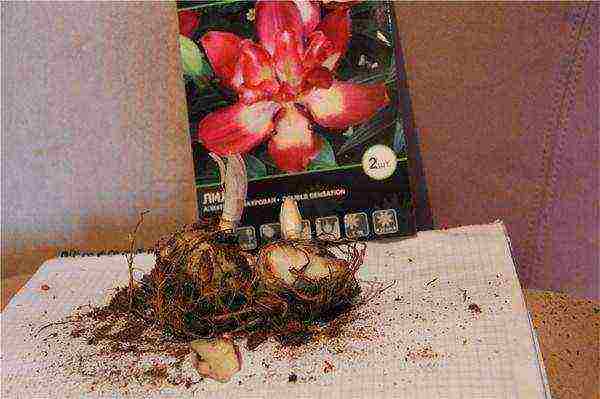
Be sure to periodically observe the bulbs during storage. If suddenly they start to sprout too early, then you need to plant them in a pot, so to speak, for seedlings. More details about this method of sprouting bulbs will be described later.
Video: how to plant lilies with sprouts in spring
Growing lily seedlings (preliminary early planting of bulbs in a pot)
As a rule, lily bulbs are always immediately planted in open ground, but in some cases it is useful to germinate them at home, so to speak, by planting them on seedlings.
This method has its advantages. You will immediately see how the flower takes root and takes root, whether it needs feeding. Plus, you will have the opportunity to know in advance where to plant the grown flower bulbs.
Before planting a lily bulb for germination in a pot, it must first be processed. To begin with, it should be well cleaned of the earth and assess its condition by its appearance. Now you need to soak the onion (only the onion, you do not need to immerse the sprout) in a slightly pink 1% solution of potassium permanganate at room temperature, and the water should be settled. There are different opinions about the duration of the soaking procedure: someone does it for 1.5-2 hours, and someone does it within a few minutes.
It is recommended to pre-disinfect the soil for planting (steam in a double boiler or fry in the oven / microwave).
It is advisable to choose a transparent container so that it is convenient to control the moisture content of the substrate. It will be good if you make drainage holes not only at the bottom, but also on the side.

You cannot plant a lily bulb in a pot deeply. This is already when planting in open ground, it should be buried at its 3 heights, when planting in a pot, it is enough to fill the bulb up to the tip of the sprout.

Advice! You can make a multi-layer bedding for better growth of lily bulbs. Pour ordinary soil down, then make a pillow of river sand, on which to put the bulb itself, and cover it with the same soil on top.
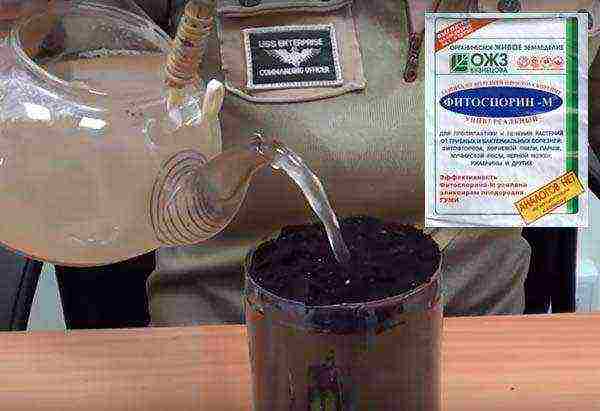
After planting, it does not interfere with spilling the earth from above with water or a solution of phytosporin (to suppress pathogens of fungal diseases). Moreover, this is necessary if you refused to disinfect the soil.
As a place for further growing lily seedlings, the most illuminated window sill or loggia is suitable.
After planting the lily bulbs in the pot, further care consists in regular watering as the soil dries up, that is, approximately 1 watering every 5-7 days will be enough. Top dressing is not necessary.
If you want to continue growing lilies in a pot at home, then keep in mind that this is still a street flower, and it requires slightly different conditions, which are rather difficult to organize at home, so it is highly likely to die.

As for the timing of planting lilies, which were warm on your windowsill at home and did not experience night and day temperature fluctuations, they need to be planted in the garden in a permanent place a little later than with direct planting of bulbs in open ground, in other words, only along the passage of all possible return frosts, that is, at the end of May - at the beginning of June. When the time is right, carefully remove the sprouted lily bulbs along with the soil from the pots and plant them outdoors in a flower bed.
Video: sprouting lily bulbs in spring in pots
Technology for planting lily bulbs in open ground
Optimal planting times
The optimal time for planting lily bulbs in open ground should be selected in accordance with the climate of your region and weather conditions. In any case, you can start planting from May. By this time, the earth should have already warmed up enough, and the likelihood of return frosts will come to naught.
Site selection and soil preparation
Depending on the variety, lilies require varying degrees of light to grow successfully in the garden. Asian, tubular and LA hybrids will only thrive in sunny or very light partial shade. Eastern and martagons are not a sin to plant in shady places. You can find out more about the lighting requirements by reading the instructions on the packaging of the bulbs you have purchased or are about to buy.
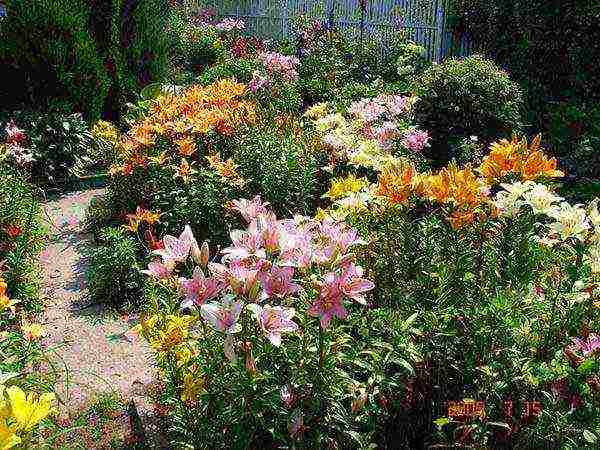
For planting lilies, it is important to find a place in the garden that is well protected from the wind.It would be great for it to blow a little. If you plant flowers in a corner completely closed from blowing, then this can adversely affect their development, namely: humid air will stagnate excessively, and the bulbs will simply trample and rot.

The main requirement of lilies for the soil in which they will be planted, as for most bulbous flowers, is good soil drainage. For example, an overly light and sandy soil will provoke a constant lack of moisture for the growth of bulbs. And for example, heavy and clayey soil, will not allow it to develop normally, and the flower will rot.
To make the soil more nutritious and suitable for growing lilies, you should add peat to the sandy soil, and again peat and additional sand to the dense and clayey soil (each one bucket per 1 square meter of flower beds).
Too acidic soil is also not suitable, therefore, to reduce its acidity, you should use wood ash (1 glass per 1 square meter of flower bed) and dolomite flour (2-3 glasses per 1 square meter of flower bed).
If you want the soil to become just perfect and as fertile as possible, then do not be stingy and pour a bucket of excellent humus or rotted compost into the planting site. You can also use mineral fertilizers, for example, use potassium sulfate and superphosphate: the first will need 50 grams (3-4 tablespoons), the second - 100 grams (6-7 tablespoons).
Planting bulbs
The basic rule for planting almost all bulbous plants is that the planting depth of the bulb should be equal to 3 times the height of the bulb itself. If your lily bulb is 3 centimeters high, then the depth of the planting hole, more precisely, the hole should be 9 centimeters.

When making a planting hole for lilies, keep in mind that drainage must be present at its very bottom. You can put expanded clay, broken brick, gravel or something else there. After such drainage, a special pillow should be made from fertile soil (just do not put the bulb directly on the expanded clay drainage), in which the flower will grow.
The distance between plantings of lilies should be in the region of 20-40 centimeters. Such a planting scheme will provide an opportunity for the normal development of the plant's root system.

By the way! Before planting, you can pre-treat the lily bulb by soaking it in a solution of potassium permanganate or in some fungicide for disinfection.

The very process of planting a lily bulb in open ground is simple: just put the bulb with its bottom on the soft bottom of the hole, fix it a little, and then sprinkle it with soil on top. After all the bulbs have been planted, water the plantings well to establish them as quickly as possible. If the earth suddenly settles after watering, then do not be afraid to add it to it.
Video: spring planting of lilies
Note! If you plant a lily candidum, then the depth of its landing is somewhat different. In no case should it be planted too deeply, because flower leaves are laid directly above the soil surface. Therefore, the onion should be covered with soil no more than 2-3 centimeters. Another important nuance is the fact that its planting can be carried out only in spring and summer, it cannot be delayed until autumn. Otherwise, special wintering leaves will not have time to form, the plant will not be able to winter normally and will die.
A slightly more complex (perhaps more promising) process of preparing a planting pit and planting lilies is offered in the next video, which we still highly recommend you watch.
Video: how to plant lilies in spring
Outdoor care for lilies
Further care for lilies in the garden is quite simple. All these plants need to flower is regular and moderate enough watering. Remember that these flowers do not tolerate excessive moisture. So, during the flowering period, they especially need watering, but they should be watered abundantly, but not often. But in dry and hot weather, you need to water the lilies more often.When the flowering is over, then watering can be completely stopped.

Note! It is impossible to water lilies by sprinkling. It is necessary to introduce moisture clearly to the root, without getting on the leaves, and even more so on the flowers.
It is better to feed lilies with the help of mineral fertilizers, because any organic matter can cause fungal diseases. Flowers respond especially well to nitrogen fertilization in spring, for example, ammonium nitrate or urea. It is good to use an infusion of wood ash.
Video: feeding lilies
Tall varieties of lilies, which have thin stems, are advisable to be tied to supports so that they do not break off and do not die.
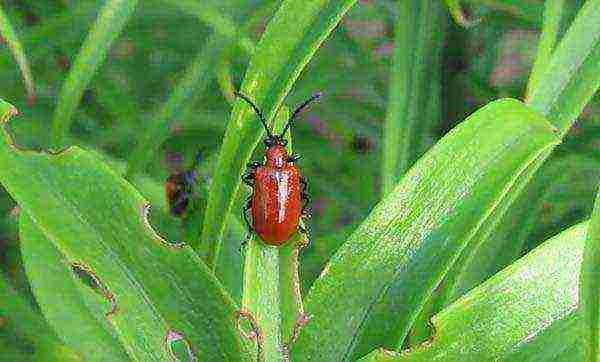
The main pest for lilies is the lily beetle, which damages the buds, leaving their ugly moves in them and even eating holes in the leaves. You can get rid of beetles by manually collecting them (preferably in the morning and in cooler weather, when they are less mobile) or by spraying flowers with insecticide preparations such as Inta-Ts-M, Corado, Commander Maxi, Senpai and Aktara.
Video: how to care for lilies - pest control
When you cut the lilies, you do not need to do this completely, you need to leave most of the stem. The more leaves you leave, the larger your bulbs will grow. And the larger the bulbs, the more buds you will have on the branch. The cut must be done obliquely. So the rainwater will quickly roll off, and not get inside, otherwise it can provoke rotting of the stem.

Advice! To prolong the flowering of lilies, remove the stamens from the flowers in a timely manner. It is recommended to do this in the morning.
Video: tips for growing lilies from an experienced gardener
Important! Read more about caring for lilies in the fall, preparing them for winter. here.
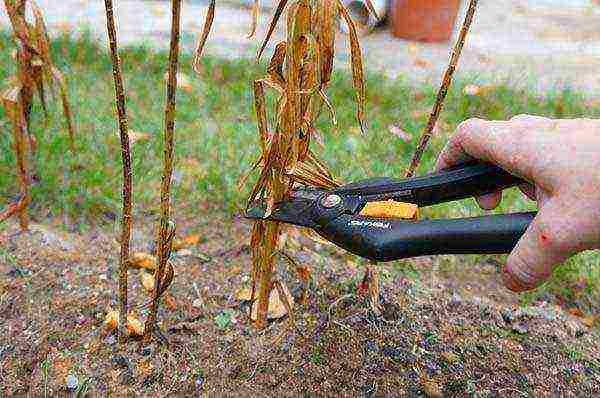
Thus, now you know that planting and growing lilies in your summer cottage is not so difficult, even a novice gardener can handle this. All you need to do is follow these simple guidelines for planting and caring for this beautiful flower. And then its abundant and bright flowering will make your garden even more beautiful.
Video: spring planting of lily bulbs in open ground
Lilies are one of the most popular flowers in summer cottages, which attract attention with their delicate, colorful and abundant flowering. Moreover, they give their own touch to the range of smells in the garden. As a rule, these flowers are planted in the fall, but recently spring planting of lilies in open ground has become popular. But in order to grow beautiful flowers, you first need to choose and buy high-quality planting material, save it until it is planted in a permanent place in the garden, plant it, and then properly care for the flower until autumn.
Content
- 1 Popular types and varieties of lilies
- 2 How to choose lily bulbs
- 3 How to keep lilies before planting
- 4 Growing lily seedlings (preliminary early planting of bulbs in a pot)
- 5 Technology of planting lily bulbs in open ground
- 5.1 Optimal landing times
- 5.2 Site selection and soil preparation
- 5.3 Planting bulbs
- 6 Caring for lilies in the open field
Popular types and varieties of lilies
As a rule, lilies, depending on their origin, are divided into the following groups of hybrids:
- Asian;
- Martagon;
- Candidum;
- American;
- Long-flowered;
- Tubular and Orleans;
- Oriental (orientalia).
There are also interspecific hybrids of lilies:
- LA hybrids (Asian + longiflorum);
- OT hybrids (Orienpits - eastern + tubular);
- LO hybrids (long-flowered + oriental);
- OA hybrids (oriental + asian).
Video: species, varieties and hybrids of lilies
How to choose lily bulbs
The choice of planting material should be approached with the utmost seriousness if you want to get a flower that will delight you with abundant flowering and decorate your flower bed until autumn.
Here are some important points to pay attention to when choosing lily bulbs:
- The optimal size of the diameter of the bulb is 2-3 cm. If the bulbs are smaller, then most likely they are after forcing, which means that you will not get flowering immediately, but only in the 3rd year.
- The bulb should be firm to the touch and the scales should not fall apart. Excessive dryness and looseness are signs of poor-quality planting material.
- The specimen should not show any obscure spots or signs of rot.
- Donets should be in good condition, without damage, and the roots should be alive, not dry or completely rotten.
- The sprout should preferably sleep. If it has already begun to stretch, then such a bulb will have to be grown at home in a pot (in case of an early purchase) or immediately planted in open ground (if you bought it in May).
- The color of the bulb does not matter. The color is influenced by the species and variety.
How to keep lilies before planting
If you bought lily bulbs in advance, or they were presented to you on March 8 (yes, it happens), then you should take care of the problem of preserving them before planting in open ground.
It is optimal to store lily bulbs in the refrigerator, in the cellar, or in the basement, where the temperature fluctuates between 2-6 degrees.
Be sure to periodically observe the bulbs during storage. If suddenly they start to sprout too early, then you need to plant them in a pot, so to speak, for seedlings. More details about this method of sprouting bulbs will be described later.
Video: how to plant lilies with sprouts in spring
Growing lily seedlings (preliminary early planting of bulbs in a pot)
As a rule, lily bulbs are always immediately planted in open ground, but in some cases it is useful to germinate them at home, so to speak, by planting them on seedlings.
This method has its advantages. You will immediately see how the flower takes root and takes root, whether it needs feeding. Plus, you will have the opportunity to know in advance where to plant the grown flower bulbs.
Before planting a lily bulb for germination in a pot, it must first be processed. To begin with, it should be well cleaned of the earth and assess its condition by its appearance. Now you need to soak the onion (only the onion, you do not need to immerse the sprout) in a slightly pink 1% solution of potassium permanganate at room temperature, and the water should be settled. There are different opinions about the duration of the soaking procedure: someone does it for 1.5-2 hours, and someone does it within a few minutes.
It is recommended to pre-disinfect the soil for planting (steam in a double boiler or fry in the oven / microwave).
It is advisable to choose a transparent container so that it is convenient to control the moisture content of the substrate. It will be good if you make drainage holes not only at the bottom, but also on the side.
You cannot plant a lily bulb in a pot deeply. This is already when planting in open ground, it should be buried at its 3 heights; when planting in a pot, it is enough to fill the bulb up to the tip of the sprout.
Advice! You can make a multi-layer bedding for better growth of lily bulbs. Pour ordinary soil down, then make a pillow of river sand, already on which to put the bulb itself, and cover it with the same soil on top.
After planting, it does not interfere with spilling the earth from above with water or a solution of phytosporin (to suppress pathogens of fungal diseases). Moreover, this is necessary if you refused to disinfect the soil.
As a place for further growing lily seedlings, the most illuminated windowsill or loggia is suitable.
After planting the lily bulbs in the pot, further care consists in regular watering as the soil dries up, that is, approximately 1 watering every 5-7 days will be enough. Top dressing is not necessary.
If you want to continue growing lilies in a pot at home, then keep in mind that this is still a street flower, and it requires slightly different conditions, which are rather difficult to organize at home, so it is highly likely to die.
As for the timing of planting lilies, which were warm on your windowsill at home and did not experience night and day temperature fluctuations, they need to be planted in the garden in a permanent place a little later than with direct planting of bulbs in open ground, in other words, only along the passage of all possible return frosts, that is, at the end of May - at the beginning of June. When the time is right, carefully remove the sprouted lily bulbs along with the soil from the pots and plant them outdoors in a flower bed.
Video: sprouting lily bulbs in spring in pots
Technology for planting lily bulbs in open ground
Optimal planting times
The optimal time for planting lily bulbs in open ground should be selected in accordance with the climate of your region and weather conditions. In any case, you can start planting from May. By this time, the earth should have already warmed up enough, and the likelihood of return frosts will come to naught.
Site selection and soil preparation
Read also:
Ideas for decorating and fencing flower beds from plastic bottles ...
Apr 27, 2018
Petunia flower beds: ideas for a beautiful design of flower beds ...
Apr 25, 2018
Planting alyssum on seedlings and in open ground: care and ...
Apr 15, 2018
A flower bed of wheel tires with your own hands: photo ideas for a flower garden
Apr 10, 2018
Depending on the variety, lilies require varying degrees of light to grow successfully in the garden. Asian, tubular and LA hybrids will only thrive in sunny or very light partial shade. Eastern and martagons are not a sin to plant in shady places. You can find out more about the lighting requirements by reading the instructions on the packaging of the bulbs you have purchased or are about to buy.
For planting lilies, it is important to find a place in the garden that is well protected from the wind. It would be great for it to blow a little. If you plant flowers in a corner completely closed from blowing, then this can adversely affect their development, namely: humid air will stagnate excessively, and the bulbs will simply trample and rot.
The main requirement of lilies for the soil in which they will be planted, as for most bulbous flowers, is good soil drainage. For example, an overly light and sandy soil will provoke a constant lack of moisture for the growth of bulbs. And for example, heavy and clayey soil, will not allow it to develop normally, and the flower will rot.
To make the soil more nutritious and suitable for growing lilies, you should add peat to the sandy soil, and again peat and additional sand to the dense and clayey soil (each one bucket per 1 square meter of flower beds).
Too acidic soil is also not suitable, therefore, to reduce its acidity, you should use wood ash (1 glass per 1 square meter of a flower bed) and dolomite flour (2-3 glasses per 1 square meter of a flower bed).
If you want the soil to become just perfect and as fertile as possible, then do not be stingy and pour a bucket of excellent humus or rotted compost into the planting site. You can also use mineral fertilizers, for example, use potassium sulfate and superphosphate: the first will need 50 grams (3-4 tablespoons), the second - 100 grams (6-7 tablespoons).
Planting bulbs
The basic rule for planting almost all bulbs is that the planting depth of the bulb should be equal to 3 times the height of the bulb itself. If your lily bulb is 3 centimeters high, then the depth of the planting hole, more precisely, the hole should be 9 centimeters.
Read also:
Ideas for decorating and fencing flower beds from plastic bottles ...
Apr 27, 2018
Petunia flower beds: ideas for a beautiful design of flower beds ...
Apr 25, 2018
Planting alyssum on seedlings and in open ground: care and ...
Apr 15, 2018
A flower bed of wheel tires with your own hands: photo ideas for a flower garden
Apr 10, 2018
When making a planting hole for lilies, keep in mind that drainage must be present at its very bottom. You can put expanded clay, broken brick, gravel or something else there. After such drainage, a special pillow should be made from fertile soil (just do not put the bulb directly on the expanded clay drainage), in which the flower will grow.
The distance between plantings of lilies should be in the region of 20-40 centimeters. Such a planting scheme will provide an opportunity for the normal development of the plant's root system.
By the way! Before planting, you can pre-treat the lily bulb by soaking it in a potassium permanganate solution or some kind of disinfectant fungicide.
The very process of planting a lily bulb in open ground is simple: just put the bulb with its bottom on the soft bottom of the hole, fix it a little, and then sprinkle it with soil on top. After planting all the bulbs, water the planting well for their early rooting. If the earth suddenly settles after watering, then do not be afraid to add it to it.
Video: spring planting of lilies
Note! If you plant a lily candidum, then the depth of its landing is somewhat different. In no case should it be planted too deeply, because flower leaves are laid directly above the soil surface. Therefore, the bulb should be covered with soil no more than 2-3 centimeters. Another important nuance is the fact that its planting can be carried out only in spring and summer, it cannot be delayed until autumn. Otherwise, special wintering leaves will not have time to form, the plant will not be able to winter normally and will die.
A slightly more complicated (perhaps more promising) process of preparing a planting pit and planting lilies is offered in the next video, which we still highly recommend you watch.
Video: how to plant lilies in spring
Outdoor care for lilies
Further care for lilies in the garden is quite simple. All these plants need to flower is regular and moderate enough watering. Remember that these flowers do not tolerate excessive moisture. So, during the flowering period, they especially need watering, but they should be watered abundantly, but not often. But in dry and hot weather, you need to water the lilies more often. When the flowering is over, then watering can be completely stopped.
Note! It is impossible to water lilies by sprinkling. It is necessary to introduce moisture clearly to the root, without getting on the leaves, and even more so on the flowers.
It is better to feed lilies with the help of mineral fertilizers, because any organic matter can cause fungal diseases. Flowers respond especially well to nitrogen fertilization in spring, for example, ammonium nitrate or urea. It is good to use an infusion of wood ash.
Video: feeding lilies
Tall varieties of lilies, which have thin stems, are advisable to be tied to supports so that they do not break off and do not die.
The main pest for lilies is the lily beetle, which damages the buds, leaving their ugly moves in them and even eating holes in the leaves. You can get rid of beetles by manually collecting them (preferably in the morning and in cooler weather, when they are less mobile) or by spraying flowers with insecticide preparations such as Inta-Ts-M, Corado, Commander Maxi, Senpai and Aktara.
Video: how to care for lilies - pest control
When you cut the lilies, you do not need to do this completely, you need to leave most of the stem. The more leaves you leave, the larger your bulbs will grow. And the larger the bulbs, the more buds you will have on the branch. The cut must be done obliquely.So the rainwater will quickly roll off, and not get inside, otherwise it can provoke rotting of the stem.
Advice! To prolong the flowering of lilies, remove the stamens from the flowers in a timely manner. It is recommended to do this in the morning.
Video: tips for growing lilies from an experienced gardener
Important! Read more about caring for lilies in the fall, preparing them for winter. here.
Thus, now you know that planting and growing lilies in your summer cottage is not so difficult, even a novice gardener can handle this. All you need to do is follow these simple guidelines for planting and caring for this beautiful flower. And then its abundant and bright flowering will make your garden even more beautiful.
Video: spring planting of lily bulbs in open ground
Did you like the article? Share with your friends on social networks:
 Lilies are very delicate and beautiful flowers that are very popular among amateur flower growers. Planting garden lilies is not difficult: this perennial plant is very unpretentious.
Lilies are very delicate and beautiful flowers that are very popular among amateur flower growers. Planting garden lilies is not difficult: this perennial plant is very unpretentious.
In order for the lily to delight us with its beauty and feel good in the open field, proper care is required, and of course, follow the rules of reproduction and planting.
Lily: characteristics of the species
Lily (Lilium) is a perennial flowering crop that belongs to the Liliaceae family. The stems of the plant are straight and tall (some varieties reach 1.5 m in height), with small glossy leaves. Flowers can be of different shapes: cup-shaped, funnel-shaped, star-shaped or bell-shaped. However, they always consist of 6 elongated petals and the same number of stamens.

Scheme: types of lilies according to the structure of the stems
Although the word "lily" literally means "completely white", the flowers of modern varieties can have different shades: yellow, orange, red, lilac, lilac, pink. Varieties with a combined color are very popular among summer residents.
The underground part of the plant is a single-tiered (less often two-tiered) root system and a bulb. It is the bulb that is the source of nutrients for the culture, as well as the reproductive organ of the species. About the cultivation of other types of bulbous plants - hyacinths, tulips.

Wild lily - the predecessor of hybrid varieties
When to plant a lily
As you know, lilies can be planted both in spring and in the middle of autumn - it all depends on the wishes of the grower.
Autumn planting is considered the most favorable. A low temperature and a sufficient amount of moisture will allow the plant to adapt and take root normally, thus reducing the stress level of the crop. That is why it is better to plant lilies in the southern regions of Russia in October.
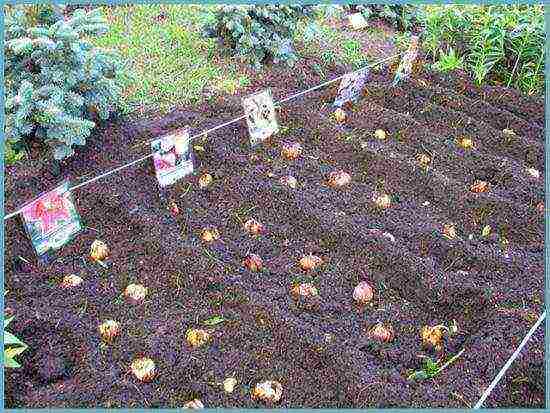
Preparing for planting lilies in open ground
However, it is worth noting that most varieties of lilies require exactly spring planting - study the characteristics of the variety you have chosen.
Choosing a place for planting lilies
Before planting a crop in open ground, carefully select a place to grow it. The plant grows well in sunny places that are protected from the wind (if you want to plant a lily near your house, observe which side of the sun is on most of the day).

Any sunny spot on your backyard is suitable for planting lilies.
When the site is selected, dig up the soil and remove any remaining roots of other plants (especially weeds). Lilies can be planted in the same flowerbed with other flowering plants - the culture will not feel bad from this. The main thing is that the "neighbors" are not too tall and do not create the shadow of a lily. For this reason, you should not plant under trees or bushes.
Soil preparation
Lily does not tolerate drought well, so the soil in which it is planted should be good at allowing moisture to pass through. Most lily varieties like fertile soils with high moisture permeability.Although breeders have also developed varieties that safely tolerate dry and even swampy areas. However, heavy loamy soils and salt marshes should be avoided when cultivating crops.
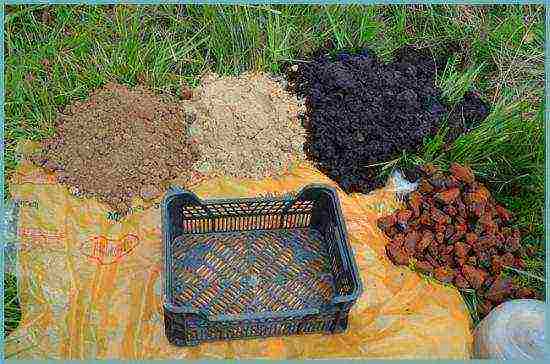
The optimal soil for planting lilies should consist of layers of gravel, sand and fertile soil.
Whatever the type of soil, it should be remembered that fertilizing the lily is still necessary. Peat fertilizers, humus or rotted compost (1 bucket per 1 m2) are suitable for feeding. If the soil is dominated by sandy impurities, then a good option for improving the quality of the soil would be phosphorus-potassium dressing, which is applied before planting the plant (100 g per 1 m2).
Important! Having well fertilized the soil when planting plants, you will provide them with comfortable conditions for growth and development for the next 2 - 3 years.
By the type of environment, the soil for lilies should be alkaline or slightly acidic. Too acidic environment is not suitable for the plant, therefore it is neutralized with wood ash (also ensures proper drainage of the soil), limestone or chalk (200-300 g per 1 m2).
Planting lilies in open ground
If you decide to plant lilies in the spring, then you should do this when the frosts have already receded, but the dry period has not yet begun. For each region of the country, the optimal time for planting lily bulbs in the ground will be different.
Prepare lily bulbs for planting as follows:
- sort the bulbs, removing spoiled planting material;
- the most viable specimens are completely cleaned of flower scales;
- rinse the bulbs in a solution of potassium permanganate or foundation (this will get rid of harmful bacteria).
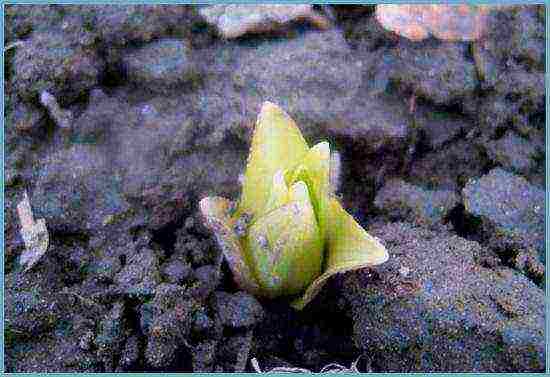
Lily sprout
The planting depth of the bulb is determined depending on the type of soil:
- in heavy soils, small bulbs should be planted to a depth of 5-6 cm, large planting material - at 13-16 cm.
- if the soil is loose, it should be planted 2-4 cm deeper than in the previous example.
Important! Only good quality bulbs with an intact root system can be planted.
After planting is complete, the plants should be fed with organic and mineral fertilizers. If you planted lilies in the fall, then cover the flower bed with dry leaves and an additional layer of soil. This will allow the planting material to avoid freezing.
Care principles
Maintaining optimum soil moisture is the first thing you need to watch out for. Watering is carried out as the soil dries up (accordingly, in dry periods, watering is done more often, and in rainy periods, watering can be excluded altogether). Use the root watering technique (called strip irrigation): surface irrigation can harm lilies. If necessary, fertilizing can be applied along with watering.
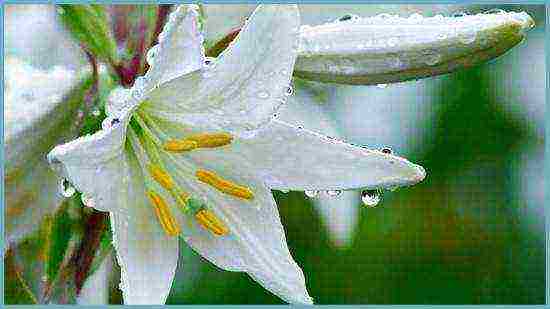
If the summer is rainy, then the lily need not be watered.
In the first year of life, the plants are rather weak. Therefore, in order to improve their development, remove all the buds: the lily will spend too much energy on flowering and, having weakened, will not be able to endure the winter frosts. But in the second and third years after planting, the plant will bloom profusely. Usually, in the fourth year, the flowering intensity decreases - this means that the crop needs feeding. Closer to the fifth year, flowers are divided and transplanted.
Advice! Do not forget to create support for the lilies: these crops often break under the weight of their own stems.
Reproduction and transplantation of lilies
Lilies are propagated by dividing the bulbs. The procedure is carried out at 4-5 years of growth of the lily: the thickening of the bulbous nests by this time is fraught with the cessation of flowering. The lily bulb is split and each part is planted separately. Care for transplanted bulbs is required the same as for plants in the first year of life. Under favorable conditions, the divided bulbs will bloom within a year.

Schematic: breeding species of lilies
Some varieties of lilies produce baby bulbs. They are attached just above the base of the main bulb.Such bulbs should be carefully separated and planted for growing. These plants will bloom only 2-3 years after planting.
There is also a more complex method of reproduction of lilies - with the help of scales. Small loose growths are carefully separated from the base of the mother bulb and planted in a special sandy mat. If the planting of scales was carried out in the spring, then by the fall, bulbs are formed from them.
Popular groups of lilies
When choosing lilies for planting in the country or in the courtyard of a private house, you should pay attention to the following groups of hybrid plants:

Asiatic lily (left) and Candidum lily (right)
- Asian hybrid lilies. Unpretentious winter-hardy varieties have cup-shaped flowers of white, pink, orange, yellow, as well as multicolored colors.
- Candidum. These varieties are capricious to growing conditions. Flowers have a funnel-shaped or tubular shape, the color is snow-white or yellow. Unlike the previous group, the flowers of these varieties have a strong aroma.

American lily (left) and oriental lily (right)
- American hybrid lilies. The varieties are well suited for breeding in central Russia. They are distinguished by moderate demands on growing conditions. The flowers are turbid with pink or lilac color and bright red dots.
- Oriental hybrid lilies. The varieties are quite resistant to external factors, but at the same time they are highly susceptible to viral and fungal diseases. Flowers of various shapes and colors. Suitable for breeding in the middle lane and southern regions of Russia.
Each of the four groups of lilies includes many varieties with similar characteristics. Choose a group based on the planting conditions and climate in your region. The variety is determined solely at the discretion of the gardener.
How to plant lilies: video
Lily varieties: photo





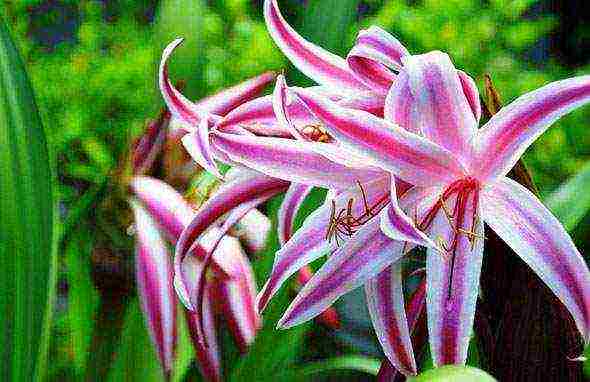
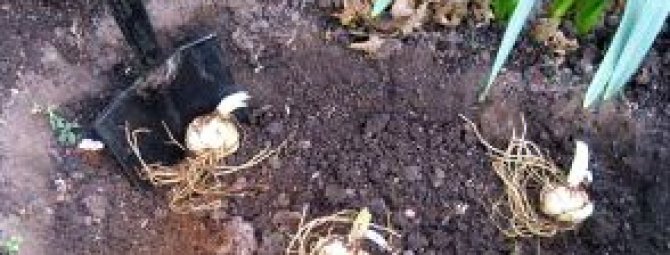
- Type: lily
- Flowering Period: May, June, July, August, September, October
- Height: 20-250cm
- Color: white, yellow, orange, red, spotted, two-colored
- Perennial
- Hibernates
- Sun-loving
- Moisture-loving
Asian, oriental, tubular, long-flowered beauties-lilies fell in love with gardeners for large accent inflorescences of bright color and unpretentious nature. There are several options for breeding and growing these beautiful plants, but we will take a closer look at how lilies are planted in the spring in the ground. A few simple recommendations - and now your dacha is buried in a lush and fragrant red-red-white cloud.
- What determines the choice of landing time?
- Spring planting of lilies
- Selection and storage of planting material
- Soil preparation and treatment
- Primary and subsequent feeding
- Features of the watering regime
- Protection from pests and diseases
- Mistakes when growing lilies
What determines the choice of landing time?
There are several opinions about the timing of planting lilies in open ground. The traditional planting time is autumn, or rather, its first half. This is due to the natural cycle of plant development: after flowering, a dormant period begins (only a few weeks), after which the growth of the bulb is activated, the roots hatch. As a result, at the very beginning of spring, along with the first rays of the spring sun, a flowering bud appears.
However, sometimes, for various reasons, gardeners choose early spring for planting work. The reasons can be any - from a simple lack of time to taking into account the characteristics of a particular variety. Suppose the oriental hybrids thrive well, but the North American varieties simply cannot withstand the harsher conditions.

Consider the benefits of an April open-air landing:
- bulbs do not need to be buried in the soil and specially insulated, a refrigerator is suitable for storage;
- home "wintering" excludes freezing and spoilage, guarantees complete safety;
- with good preparation of the soil and bulbs, the plant has time to develop and bloom on time.
There are also disadvantages worth mentioning. For example, in some varieties, the root system does not have time to fully develop, and plants exist only thanks to the strength of the bulb. It is clear that neither the desired growth nor beautiful inflorescences should be expected. Another unpleasant nuance is the absence of children in the "spring" lilies, which are often used for reproduction. By the way, crops planted in autumn give about 10 healthy children.

Tubular varieties are not susceptible to diseases and frost resistant, therefore they are recommended to be grown even in the northern regions.
If the summer is short and cold, experts recommend refraining from planting in spring - lilies are likely to bloom only next year (in this case, it is rational to plant them in October). For more convenient care of the flower garden, it is better to place spring and autumn plantings in different places, since soil preparation, irrigation regime, and top dressing will be radically different.
In late spring, at the end of May, as well as at the beginning of summer, it is not worth planting lilies - the plants grow weak and unprepared, more susceptible to disease. The most suitable period for planting in the middle lane is the end of April.
Spring planting of lilies
If you missed the fall season or just decided to experiment, remember that spring planting is somewhat different. Both the soil for the lilies and the plants themselves require additional processing.
Selection and storage of planting material
Beautiful, tall lilies can only be grown from bulbs that have no signs of diseases - rot, mold, specks, scales that differ in color or texture. The roots should be "live", not dried, about 5 cm long. If the purchase takes place in the spring, it is better to purchase the bulbs that have already given small sprouts.

Healthy bulbs are easy to identify by their appearance: the scales of a uniform white or yellow color do not have extraneous inclusions, and the roots are strong and elastic, without spots
Suppose you have prepared your own planting material since the fall and want to keep its best qualities until spring. Place the bulbs on the bottom shelf of the refrigerator and check their condition regularly. Perhaps some will grow and shoot ahead of schedule. The sprouts must be preserved and the bulbs can be planted in special containers or regular flower pots. As soon as the frost ends, take out the "sleeping" and sprouted specimens into open ground.
There are several effective preventive measures to protect planting material from fungus and pathogenic bacteria. Disinfection of bulbs is carried out with well-known solutions, for example:
- washed in clean water, and then placed in a weak solution of manganese for 25-30 minutes - 5-10 g of substance per bucket of water;
- kept in a solution of the fungicide "Fundazol" (according to the instructions);
- remove damaged scales, rinse thoroughly in 2-3 waters, place in a solution of karbofos (1 tablespoon of the substance is enough for a bucket of water) - if traces of infection are seen on the bulbs.
The protection effect will increase if the nests are insulated after planting. The easiest way is to use plastic jars or bottles with the top half cut off. Inverted containers act as mini-greenhouses for escapes.

The shade of the buds of some varieties directly depends on the degree of illumination, and in partial shade the color becomes more saturated, bright, deep
If you need to transport the bulbs or store them for several days "over-exposed", place them in any convenient container, covered with wet moss, loose soil, sand or sawdust.
A little advice for lovers of Asian hybrids that reproduce with stem bulbs (formed at the time of ripening in the leaf axils).For storage in the winter, they are placed in hermetically sealed plastic bags and pots with peat are placed, which are installed in a room or refrigerator with a temperature of 1-3 ° C.
In the process of purchasing, do not forget to clarify the variety of lilies - the place, time and conditions of planting, as well as growing techniques, depend on this.
Soil preparation and treatment
To describe in general terms the properties of the soil useful for growing lilies, then it should be loose, healthy, alkaline, moist.

One of the soil options for growing lilies: a mixture of sod land, peat, river sand, coniferous litter in equal proportions. You can add a primer for flowers
To do this, before the spring planting, when the ground has thawed and became relatively soft, we carry out preparatory measures:
- digging up the topsoil (35-40 cm deep);
- we arrange drainage for the outflow of excess water;
- if other types of plants were previously grown on this site - add fresh soil or substrate;
- we enrich the soil with humus or phosphorus-potassium fertilizers;
- we reduce the acidity to the level of 6.5 pH (a pound of chalk or 200 g of wood ash per 1 m³ of soil);
- water the soil periodically to keep it moist.
A layer of gravel or river pebbles can be used as drainage. In order for the bulbs to grow healthy, large and strong, you can add a little needles mixed with sand to the soil. The main thing is no biological fertilizers, especially manure! Put a layer of peat, rotted sawdust or compost on top.
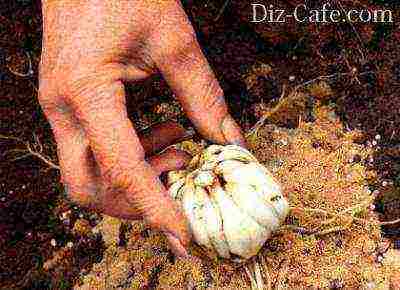
When planting lilies in open ground in April, be sure to check the condition of the soil - it must be thawed, soft and loose
We choose a sunny place and dig shallow pits (up to 10 cm), although much depends on the choice of the variety. With the exception of some species, the bulbs are usually placed at a depth equal to three diameters.
Some gardeners, in order to protect the shoots from sudden spring frosts, dig holes a little deeper, but they adhere to the rule: the lighter the soil, the deeper the hole. Thus, we plant low-growing crops to a depth of 8 to 12 cm (depending on the size of the bulb), tall ones - from 12 to 20 cm.If the roots are strong enough, add another 5 cm.
Planting intervals, like hole depth, depend on the variety. It is enough to leave 15-20 cm between low-growing plants, tall and powerful plants should be separated from each other by an interval of 25-30 cm.

The development of plants depends on the depth of the holes and the intervals between them: tightness does not benefit flowers, the flower garden looks unkempt
Make sure that the lily landing site is not flooded with spring waters. If you want the inflorescences to be turned towards the house or path, try to plant them to the north of the objects.
Primary and subsequent feeding
Regardless of the time of planting flowers, the soil must be fed with mineral fertilizers. Avoid cow dung, especially fresh cow dung. It negatively affects bulb growth and plant development during flowering.
Depending on the type of soil, the following additives are added to the soil in the spring:
- ammonium nitrate (1 tbsp. spoon per 1 m³ of soil);
- nitroammofosk (up to 50 g per bucket of water);
- wood ash.
When nourishing the soil, it is necessary to observe strict dosage, since an overabundance of minerals also negatively affects the development of sprouts. The only substance lilies really love is wood ash. It can be added up to 5-6 times during the season. Ash not only forms an alkaline environment that is beneficial for flowers, but also protects against certain types of pests and mold.
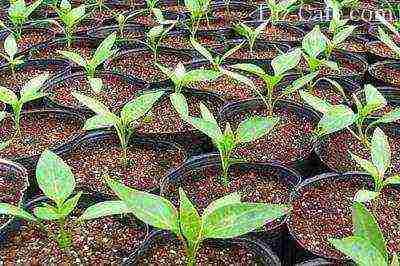
Sometimes, especially in the northern regions, before planting in open ground, lilies are planted in containers or flower pots - until the soil is completely thawed
Plants planted in spring, in addition to the initial feeding, must be fertilized at least 2 more times.Before the formation of buds, the soil should be impregnated with a solution of nitrophoska, and after the flowering period - with a solution of superphosphate (40-50 g per bucket of water). The last dressing nourishes the bulbs, prepares them for the winter period.
Simultaneously with mineral fertilizers, prevention of diseases is carried out. In May, when the sprouts are a little stronger, saturate the soil with 1% Bordeaux mixture. Repeat the procedure a couple more times in July, but this time by spraying the entire plant. If you notice signs of diseases on the plant, for example, gray rot, continue feeding - the bulbs need additional nutrition.
Features of the watering regime
Prepared and fed soil is useless if you do not follow the correct watering from the moment the bulbs are planted. On the first day, the soil must be thoroughly watered, and then watered regularly, observing two important conditions:
- prevent stagnation of water;
- do not overdry the soil.
Any violation entails a suspension of development, as a result of which budding and the entire flowering process will not fully occur. Proper watering provides the most important thing for flowering crops - lush, healthy, beautiful inflorescences.
It is for a longer preservation of moisture that needles or rotted sawdust are mixed into the soil - they are saturated with water and do not allow the soil to dry out. Do not plant lilies too densely to distribute moisture evenly and in sufficient quantity.

The choice of a planting site largely depends on the capabilities of the summer cottage, but try to keep the plants in a bright, well-lit area or in a light partial shade
Morning and afternoon hours are suitable for watering. Water gently, try to spray water in the root area. Splashes on leaves can cause disease (eg botrytis) or burns. Water droplets are a kind of lens that concentrates sunlight. In this sense, consider such a method of irrigation as drip irrigation - water at regular intervals flows directly to the roots of plants, providing them with a strictly metered amount of moisture.
Why is waterlogging scary? In cloudy, cool weather, dampness favors the development of brown spot, and in heat - wet rot and fusarium.
Protection from pests and diseases
Consider the dangers that lie in wait for plants planted in April-May.
In the early spring period, you can encounter such a nuisance as bacterial (wet) rot. It manifests itself in the form of yellowish stains-streaks, appearing first on the leaves, then moving to the peduncles. Over time, the entire plant becomes infected, and the affected areas simply die off. To protect yourself from this scourge, you should reduce watering and exclude nitrogenous fertilizers.
Small, but brighter, red spots on the leaves signal another disease - rust. It is carried by the bulbs, so you should carefully select the planting material. Infected leaves gradually dry out, so they are removed immediately. Bordeaux liquid, some fungicides are suitable for treatment.
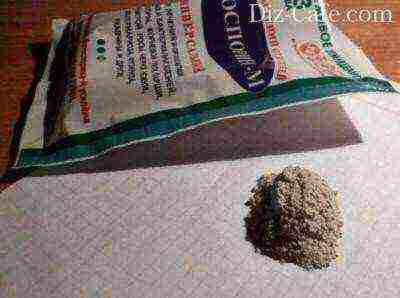
Fitosporin is an excellent remedy for the prevention and treatment of fungus and bacterial diseases - scab, black leg, root and gray rot, phytophthora, rust
The real scourge for lilies is botrytis (gray mold). The infected plant becomes covered with rapidly spreading brown spots. The reasons for the appearance can be different, but the most common are waterlogging and a sharp change in temperature. To avoid mold, it is necessary to loosen the soil more often and treat the plants with substances containing copper.
If the tops of the sprouts begin to turn yellow, root rot has appeared. She lives only on the roots of the bulbs. We'll have to pull out the plant, remove diseased parts and disinfect.
Lilies can be harmed not only by diseases, but also by harmful representatives of the fauna: thrips, aphids, squeak beetle, larvae of beetles and click beetles, spider mites. A number of chemicals have been created for their destruction, for example, "Inta-Vir". Insecticides cannot cope with the squeak beetle, so it should only be removed manually. The bright orange lily beetle is usually destroyed in a similar way.
Lily flies, thrips, aphids, beetle larvae are removed with the chemical preparations "Thunder", "Povotox", "Mukhoed", "Pochin", "Medvetoks", "Grizzly".
Bulbous plants are sometimes invaded by mice. In addition to the generally accepted mesh fences, planting of snowdrop, daffodil or colchicum is used to protect against rodents.
Mistakes when growing lilies
Some mistakes associated with planting lilies in spring and further caring for a flower garden are fraught with plant death, so try to avoid them in the first place:
- Planting bulbs in a low-lying area. This is a critical flooding zone, which means that lilies sensitive to waterlogging in such a zone will simply die.
- Violation of the watering regime. A long period of drought, like waterlogging, is dangerous for flowers. Water less often, but more abundantly.
- Fertilization of plantings with manure. Threatens with a whole range of diseases. Instead of mullein, use humus, or composts like "Bogatyr".
- Overheating of the soil. Direct rays of the sun and high temperatures harm the plants. Exit - landing in partial shade and mulching with dry grass or sawdust.
As you can see, the rules for planting and caring for lilies are unpretentious, and for a good result, only one thing is important - regularity. Do not expect abundant flowering from spring plantings in the first year, but next year the beauty and splendor of the flower beds will surpass all your hopes.
And finally, a few more tips on the video:
>


